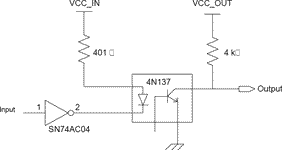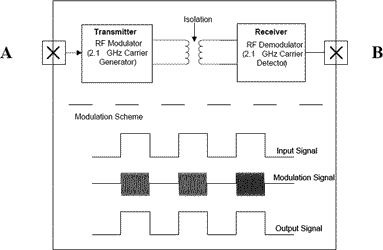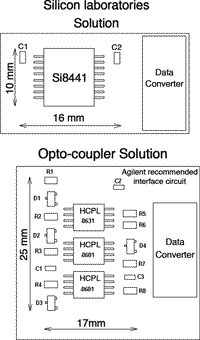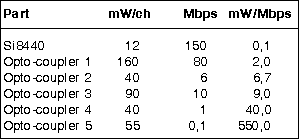
Industrial plants are noisy and often hazardous environments. Nevertheless, critical analog signals such as temperature, pressure, flow rate and gas concentrations, must be attained to ensure the safety of the control system and its operator.
As shown in Figure 1, numerous modulation techniques are used to first encode an analog signal then transmit the signal across the barrier. Once across the barrier, a filter or demodulator reconstructs the analog signal. Systems like this might directly drive a safety shutdown circuit and automatically shut down a system once a preset threshold is exceeded. Reaction time is critical in these systems and is usually dictated by the propagation delay of the isolator.

Numerous other systems (Figure 2) such as audio, video and motor control also use isolation. However, these systems typically use isolation to minimise ground loops and thus enhance the integrity of data transmission across the system. These systems generally use discrete, high-resolution, 8- to 16-bit (high fidelity audio systems use 24-bit) analog-to-digital converters (ADCs) and/or digital-to-analog converters (DACs) with 100 Ksps (kilo-samples per second) to tens of Msps throughput. The ADC/DAC that is chosen depends on the quality and budget constraints of the system being designed. For instance, in the typical audio system, a DSP acquires the digital content from a CD. The DSP then processes the information, adds the appropriate sound effects (2, 4 or 8 channel audio) and then transmits the post-processed digital bit stream to an audio DAC (filter/demodulator in Figure 1). The analog signal from the DAC is then routed to the speakers to recreate the desired sound. As mentioned, many audio systems (especially 24-bit hi-fidelity systems) like to isolate the DSP's processing ground planes from the power (speaker) planes. This technique is used to minimise ground loop pickup and hence reduces background noise and audible humming.

Audio and video systems also require very high-speed isolated data transmission with minimal propagation delay to ensure a high quality reproduction of the original audio or video content. Audio systems typically use 48 Ksps ADCs, while video systems require much higher data converters, typically using a minimum of 1 Msps to as high as 10 Msps data converters. To transmit a serially-encoded 14-bit, 10 Msps data stream across an isolated barrier requires a 140 Mbps isolator. Only a modern digital isolator can accomplish this task.
Opto-couplers vs digital isolators
Both opto-couplers and digital isolators are used to isolate and provide a communication link across a barrier. There are inherent advantages to using each technology.
Opto-couplers
Opto-couplers are devices used for communicating across isolation barriers. They consist of a light-emitting element and a photo detector element (see Figure 3). Both elements are usually integrated into the same package; however, no electrical or physical connection exists between the two elements, just a beam of light. The light emitter element is usually an LED (light-emitting diode). The photo-detector elements could be one of a number of elements but usually consist of a photodiode or phototransistor [1].

Opto-couplers have been the workhorse for isolation in intrinsically safe systems for decades. They are relatively economical, especially if the transmission speed stays below 100 Kbps, and can transmit analog signals across the boundary. Unfortunately, they consume large amounts of real estate (typically one channel per package) and suffer from limited throughput (up to tens of Mbps maximum). Moreover, they require numerous discrete components, and performance degrades as the ambient temperature increases.
As system temperature increases, the required drive current on the opto-coupler in many cases doubles because the CTR (current transfer ratio, a ratio that indicates the amount of input signal transferred to the output) can degrade by up to 60% as temperature deviates from 25°C to 100°C. This increases opto-current drive requirements and system cooling demands. Such temperature gradients are common in motor control applications [2]. Regardless of their limitations, they typically provide 3 kV of voltage isolation and only consume hundreds of milliwatts.
Digital isolators
The operation of digital isolators is analogous to that of an opto-coupler, except an RF carrier is modulated instead of light. This simple architecture provides a robust isolated data path and requires no special considerations or initialisation at startup. A simplified block diagram for a single Si8440 channel from Silicon Laboratories is shown in Figure 4. A channel consists of an RF transmitter and receiver separated by a transformer. Referring to the transmitter, input A modulates the carrier provided by an RF oscillator using on/off keying and applies the resulting waveform to the primary of the transformer. The receiver contains a demodulator that decodes the input state according to its RF energy content and applies the result to output B via the output driver.

Digital isolators provide unidirectional, highly sensitive and stable, repeatable switch points. Their integrated transformers use standard CMOS chip-scale technology utilising silicon dioxide to provide galvanic isolation. RF couplers have a higher peak data rate of up to 150 Mbps, more than 10 times faster than traditional opto-couplers. Also, RF coupler technology is CMOS scalable to even higher throughput rates [3].
RF couplers provide transient immunity of better than 30 kV/μs, compared to 10 kV/μs for opto-couplers. They also provide up to 2500 VRMS of isolation. RF couplers are also more immune to temperature than opto-couplers as their process parameters are not as subject to process effects. Many easily operate up to 125μC. Again, the biggest advantage RF couplers have over opto-couplers is size. They are typically fabricated in a small die area per channel and many are available in SOIC packaging allowing multiple channels per package [3]. A drawback of RF couplers is their limited operating voltage range, which significantly limits their use in high-voltage applications. They are typically limited to operate from a 5 V supply. Figure 5 illustrates the PCB real estate impact digital isolators have.

Table 1 illustrates the energy savings and throughput enhancements of a digital isolator over several opto-couplers.

Safety considerations
To protect users from electric shock, the majority of these applications (especially those that require intrinsic safety) will require 2500 VRMS isolation capabilities. For example, 220-240 V applications require double protection to ensure operator safety. To achieve double protection isolation, the end system must have no copper traces within an 8 mm isolation boundary area between the safety extra-low voltage (SELV, voltages <30 VRMS) and the hazardous voltage (voltages
>30 VRMS). This boundary should have a conformal coating, such as solder resist, and any device that crosses the boundary must provide 2500 VRMS isolation minimum. To satisfy these opportunities, an 8 mm wide package must be used. Moreover, two commonly used product safety standards for end-equipment certifications include the IEC61010-1 for test and measurement instruments and the IEC60950-1 for information technology equipment.
To reduce the time and cost of end-product certifications of IEC61010-1 and 60950-1, isolators are typically certified to Component Programs at Underwriter Laboratories, CSA International and VDE Testing and Certification Institute. The process to achieve component certification approvals is rather stringent. It typically entails JEDEC type qualification as well as high potential (hi-pot) testing at the rated isolation voltage for 60 seconds at an independent testing body. After the initial qualifications, a site inspection at the manufacturer's facility occurs where the isolation device is inspected to undergo a production hi-pot test for 1 sec at the rated isolation voltage to ensure compliance.
Common component certifications include: UL1577, CSA#5A and VDE60747-5-2.
Summary
Digitally controlled systems mandate faster isolation technologies. As this article discusses, there are a number of bandwidth bottlenecks currently encountered when implementing high-speed isolation barriers in various audio, video and industrial systems. One can implement an intrinsically safe system using two architectures to solve the bottleneck issue caused by the isolator. Of all the couplers, only the emerging silicon isolator technologies solve the isolated data throughput problem. In sum, digital isolator technology provides the lowest cost, lowest latency, highest bit rate and most integrated isolation path. This emerging and scalable technology overcomes the digital barriers using isolated analog data transmission.
References
[1] Horowitz, Paul and Winfield Hill. The Art of Electronics. 2nd ed. New York: Cambridge University Press, 1995.
[2] Opto-isolators v 2.04. Which Online. August 4, 2004.
[3] Si8440/1/2 Datasheet. Silicon Laboratories, Preliminary Rev. 0.3 April 2006.
| Tel: | +27 11 608 0144 |
| Email: | [email protected] |
| www: | www.nuvisionelec.com |
| Articles: | More information and articles about NuVision Electronics |

© Technews Publishing (Pty) Ltd | All Rights Reserved